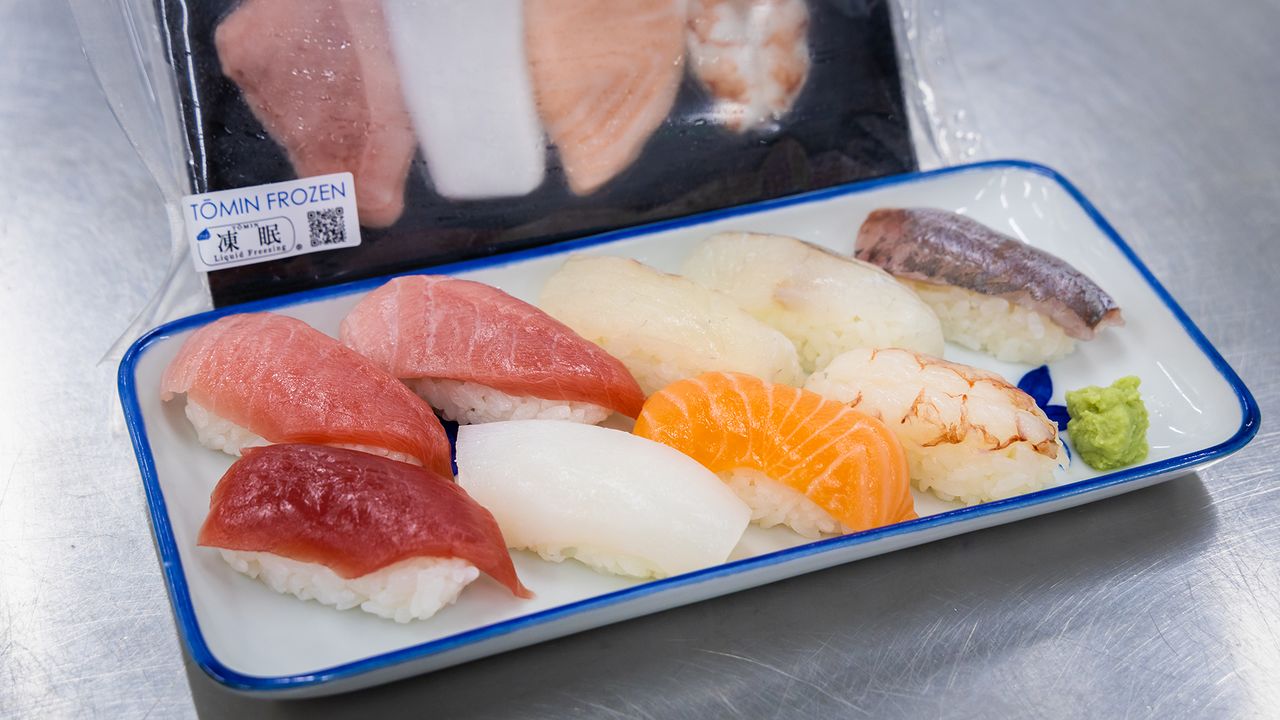
Flash-Freeze “Nigirizushi”: A Promising Sushi Treat
Guideto Japan
Food and Drink Lifestyle- English
- 日本語
- 简体字
- 繁體字
- Français
- Español
- العربية
- Русский
Respected Fish Seller Innovates
Nigirizushi, a signature item in the Japanese cuisine repertoire, is available everywhere from high-end sushi bars to conveyor-belt sushi restaurants. It is also a popular takeout food, offered in large and small packs at supermarkets and even convenience stores.
While, take-home sushi has its advantages, it is not an ideal way to enjoy the cuisine. Raw fish poses food safety risks in summer, and the vinegared rice bed on which the fish lies tends to dry out. Subsequently, there is a vast world of difference between takeout nigirizushi and that freshly made. However, Tōshin Suisan, a fish seller with outlets at Tokyo’s Toyosu Market and elsewhere, has developed frozen nigirizushi that promises great taste and extended preservation.
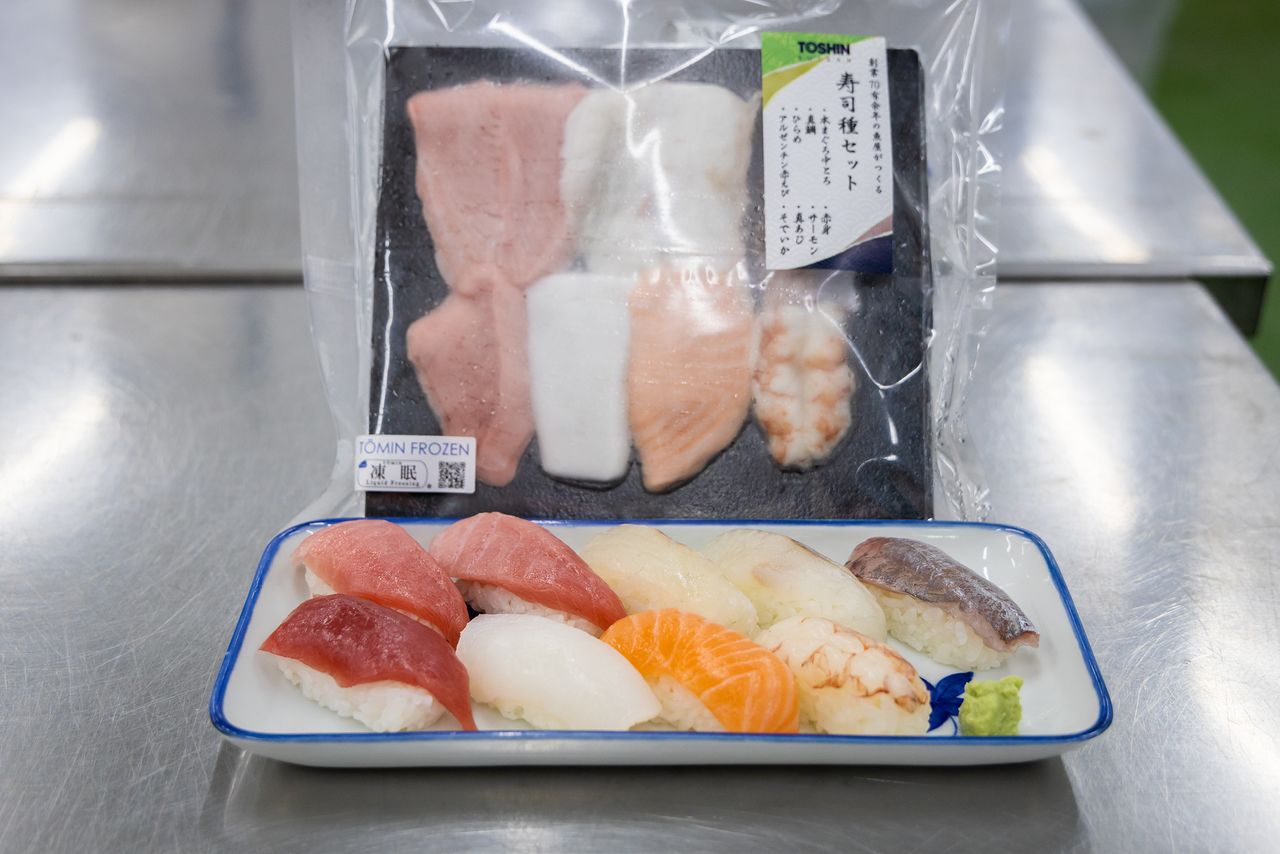
Thawed nigirizushi and the frozen sushi set.
The frozen sushi set contains nine items: two slices of medium-fatty tuna caught off Nagasaki Prefecture and one slice each of regular tuna, Norwegian branded Aurora Salmon, red sea bream, flounder, diamond squid, prawn, and horse mackerel. The set sells for ¥2,200, a reasonable price for savory lineup that includes rice beds that are properly moist. Even after dethawing, the squid and horse mackerel remain fresh-looking, with no discoloration, and the remarkable quality of the offering leads one to doubt that it was frozen at all.
Tōshin is well known as a top-class fish purveyor, with over 70 years in the business and outlets in places like Ogikubo, its main store, and branches at Ginza Mitsukoshi and other high-end department stores. According to Tōshin’s public relations officer Takahashi Jun’ichi, the company’s frozen sushi set brings nigirizushi to people who are too busy to make it to a store before closing time or whose neighborhood has no sushi bar or fish shop.
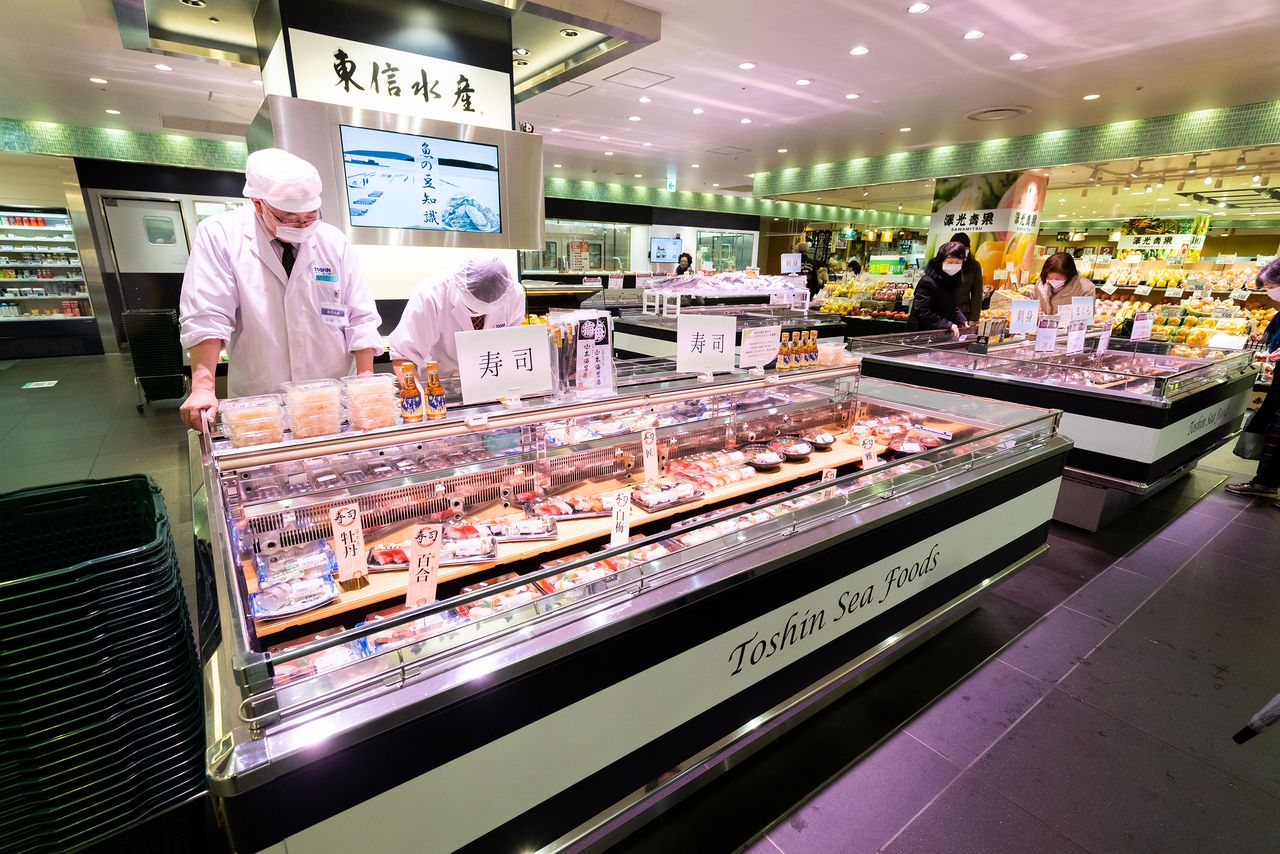
Tōshin’s main store inside the Town Seven building at JR Ogikubo Station.
Rapid Freezing Preserves Freshness
Tōshin company came up with the idea for the product to help counter the ongoing decline in fish consumption. Consumers today are less inclined to prepare fish due to the work involved, a situation exacerbated by a lack of staff at many small supermarkets able to clean and filet whole fish. In response, Tōshin set up its central kitchen, the Tōshinkan, in 2018, where it processes and supplies seafood items including sashimi, fish filets, sushi, and deli foods to close to 100 stores in and around Tokyo.
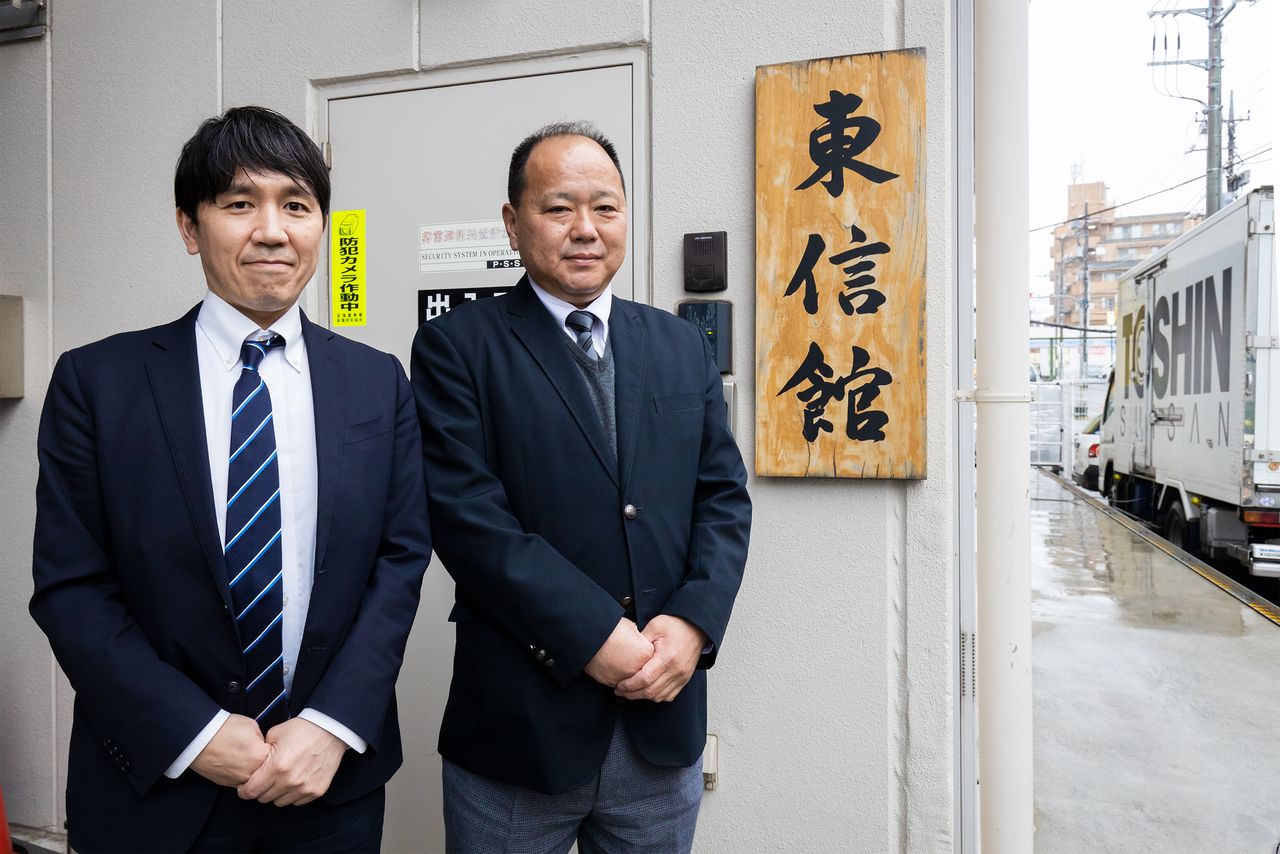
Public relations officer Takahashi Jun’ichi, left, and commercial department head Kosuge Masamitsu outside the Tōshinkan near the company’s Ogikubo main store.
Frozen food sales have increased over the past few years as more people stayed home during the pandemic. Frozen fare is not only convenient, but also helps cut food loss as items can be preserved for a long time. Inspired by the United Nations’ Sustainable Development Goals on food loss, Tōshin began developing frozen sashimi and nigirizushi that can be shipped easily anywhere in Japan. The firm says that another motivation was to dispel the common perception that fish, particularly sushi, is not tasty unless eaten immediately after preparation.
Frozen sushi is not a novel idea. There are already several types on the market, but while fish toppings tend to be of reasonably good quality, the rice beds are typically not up to snuff. Dryness is a common problem, but Tōshin found the grain retained its quality when rapidly frozen using a liquid freezer machine developed by Yokohama-based manufacturer Technican.
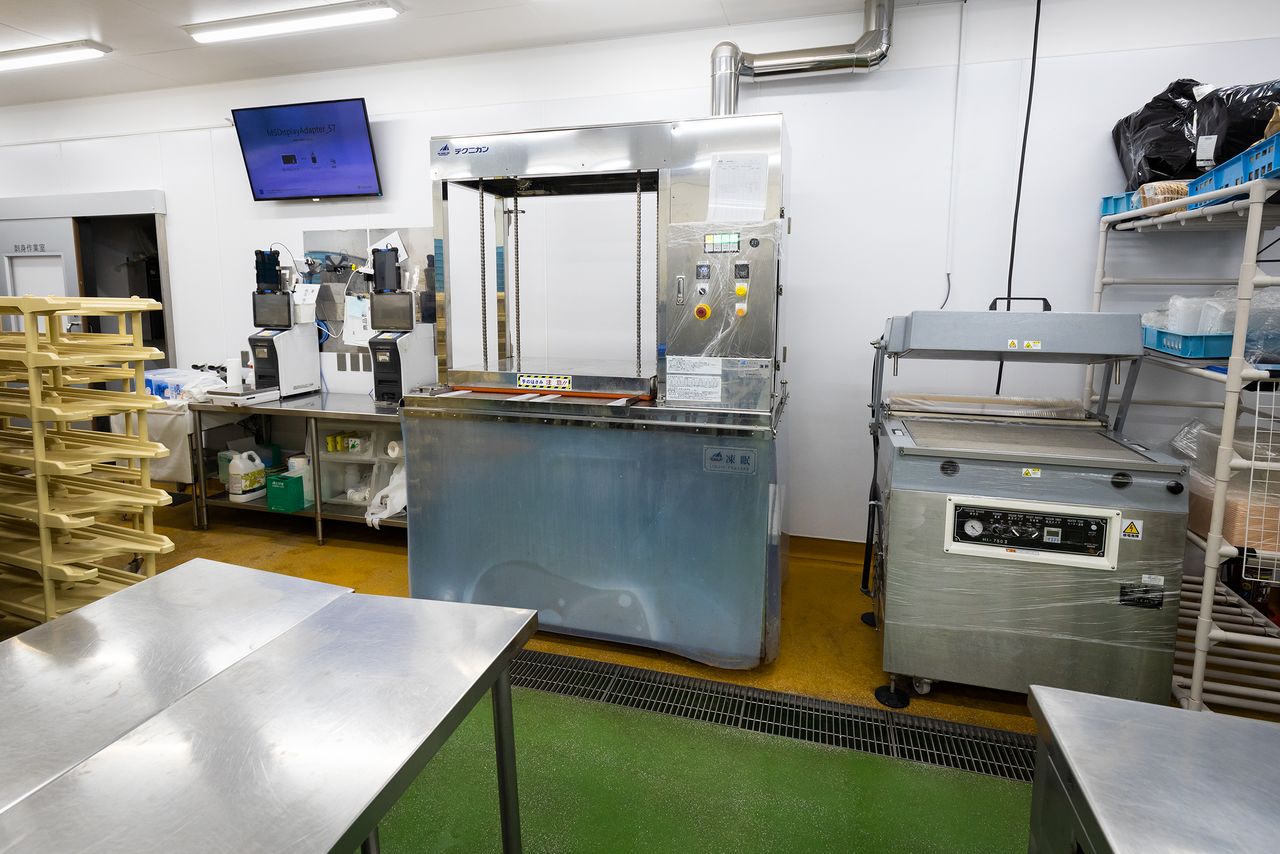
The sushi set is processed using the Tōmin rapid freezing machine (center) and a vacuum packer (right).
The rapid freezer works to quickly chill vacuum-packed foods with a liquid containing roughly 50% alcohol cooled to -30°C. The use of alcohol has an advantage over freezing methods using cooled air as it has superior heat conductivity. According to Technican, liquid conducts heat better to solids, noting that it easier to withstand a sauna heated to 90°C but not hot water heated to the same temperature.
Alcohol has a low coagulation point, meaning that it does not freeze even at sub-zero temperatures. Alcohol cooled to -30°C can cool foods eight times more quickly than nitrogen gas cooled to -100°C. For food safety reasons, Tōshin packs the fish slices and the rice in its nigirizushi set separately, but both take as little as 15 minutes to freeze.
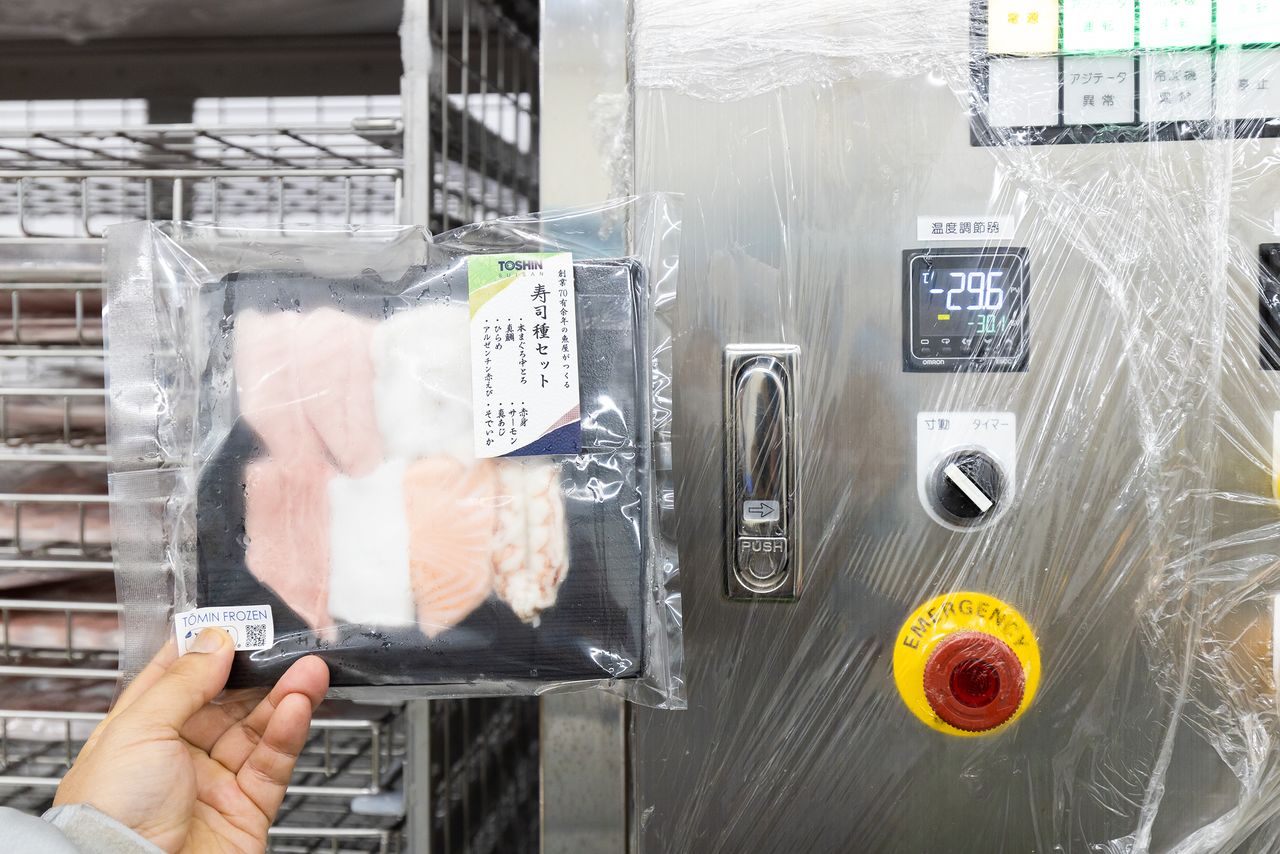
The liquid freezer’s control panel showing an interior temperature of -29.6°C and a freshly frozen nigirizushi set.
Sealing Freshness In
Rapid freezing ensures that foods stay tasty after thawing. Kosuge Masamitsu, who head’s Tōshin’s commercial department, explains that foods often expand during cooling when in the 5°C to -5°C temperature range. But rapid liquid freezing shortens this window, thus minimizing expansion.
The reddish liquid exuded by thawing fish or meat, called “drip,” is the result of damage to the tissue structure as expansion occurs, leading to loss of moisture, protein, and umami. Rapid liquid freezing cuts down the time the fish is in this temperature “danger zone,” allowing freshness to be sealed in. The same process also helps keep the rice moist and soft.
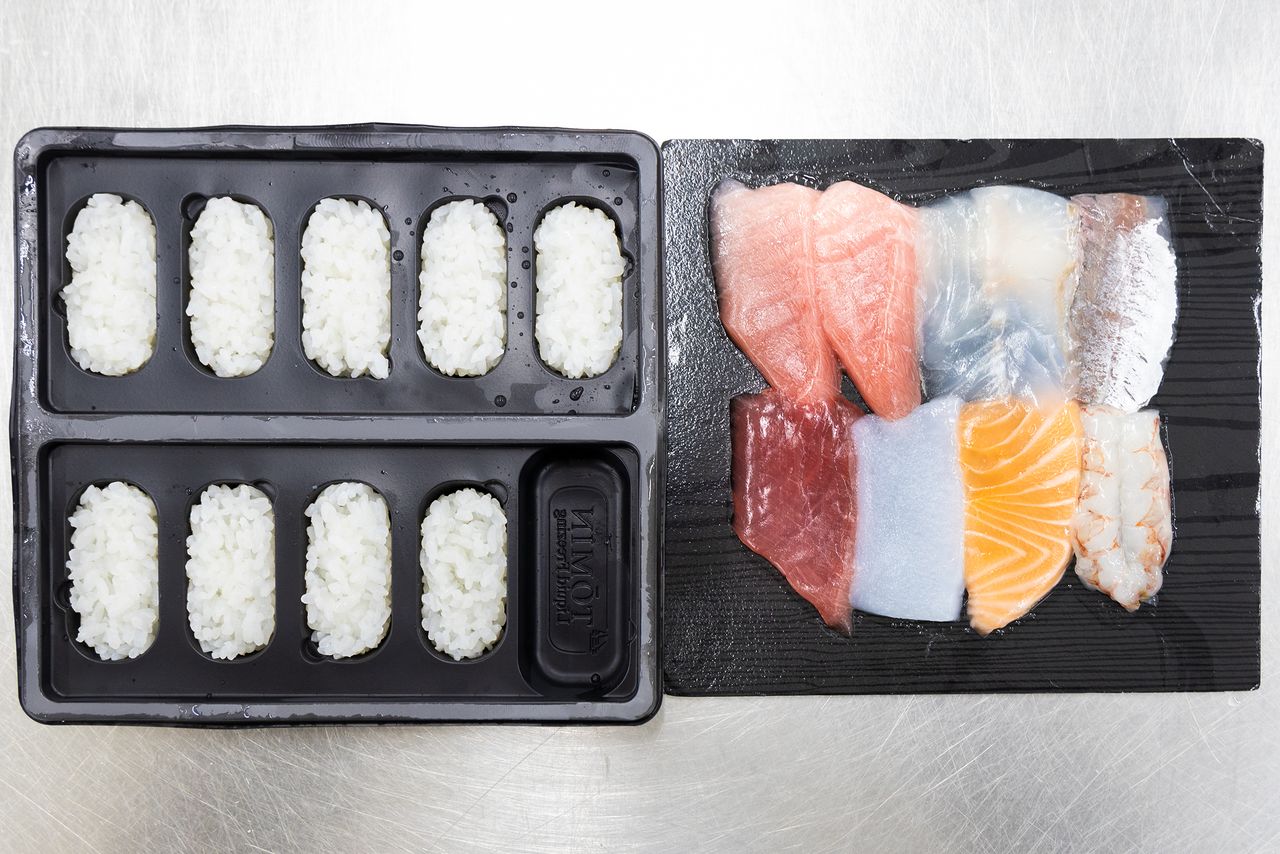
The sushi set immediately after thawing. There is virtually no drip from the fish, and each grain of rice is perfectly plump.
In most cases, fish arrives at Tōshinkan the day after being caught for processing at peak freshness. It is then vacuum-packed, an important step as removing air increases the surface area exposed to the liquid and heightens freezing efficiency. This process is the backbone of Tōshin’s extensive distribution network, which it has developed over its many decades of experience handling fish.
The quality of the sushi set can be maintained for 180 days after freezing if stored at -60°C in industrial freezers. After purchase, the sets will keep for up to four days in a household freezer. The fish can be thawed by immersing the pack in ice water for 20 minutes, and the rice can be dethawed by placing it for 1 minute and 30 seconds in a microwave or 10 minutes in a steamer.
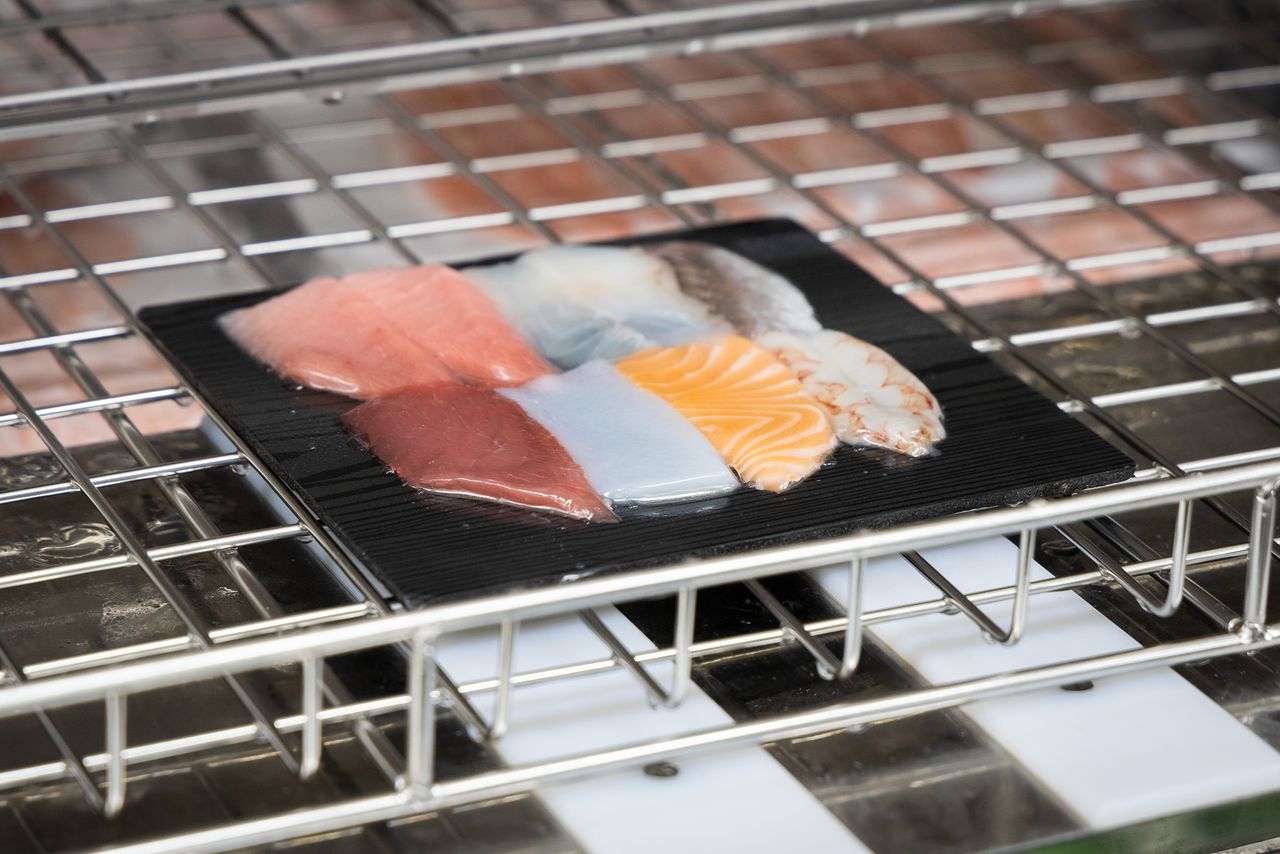
A sushi set is placed in the liquid freezer after vacuum packing. Compared to vacuum packing in bags, this method keeps liquid “drip” to a minimum.
Seasonal Fish All Year Round?
Tōshin’s method ensures that fish stays tasty for up to six months, opening the possibility that fish lovers someday can enjoy popular varieties even out of season. For instance, saury, normally at peak flavor in autumn, would be available in spring, the first bonito appearing in April and May could be enjoyed in autumn, and tuna caught off Ōma in Aomori Prefecture in the depths of winter might find its way to plates in spring and summer.
Abundant catches of dark meat fish like sardines, chub mackerel, and horse mackerel could be frozen the same way, making supplies available year-round to use as sashimi or sushi. In line with United Nations’ SDG goals, this would also help stem food loss. Fish that has lost its freshness will not sell and is used instead for bait or fertilizer.
Tōshin is feverishly working to add more varieties to its frozen fish lineup, such as popular sushi toppings like sea urchin and salmon roe. At the moment, Tōshin only offers the product online, but envisages selling its sushi set in stores as well, if proper freezers can be installed. In addition to its sushi, Tōshin also sells seafood donburi rice bowls and grilled fish online. Sales are gradually picking up as word gets out.
Expanding the Market
In the future, it may be possible for consumers to enjoy authentic nigirizushi and seafood donburi without having to go to a sushi shop. In addition to in-home use, Tōshin anticipates growing demand among travelers and from overseas. It is also seeing burgeoning interest from such unexpected quarters as retirement homes, with the company recently delivering 30 seafood donburi to one such facility.
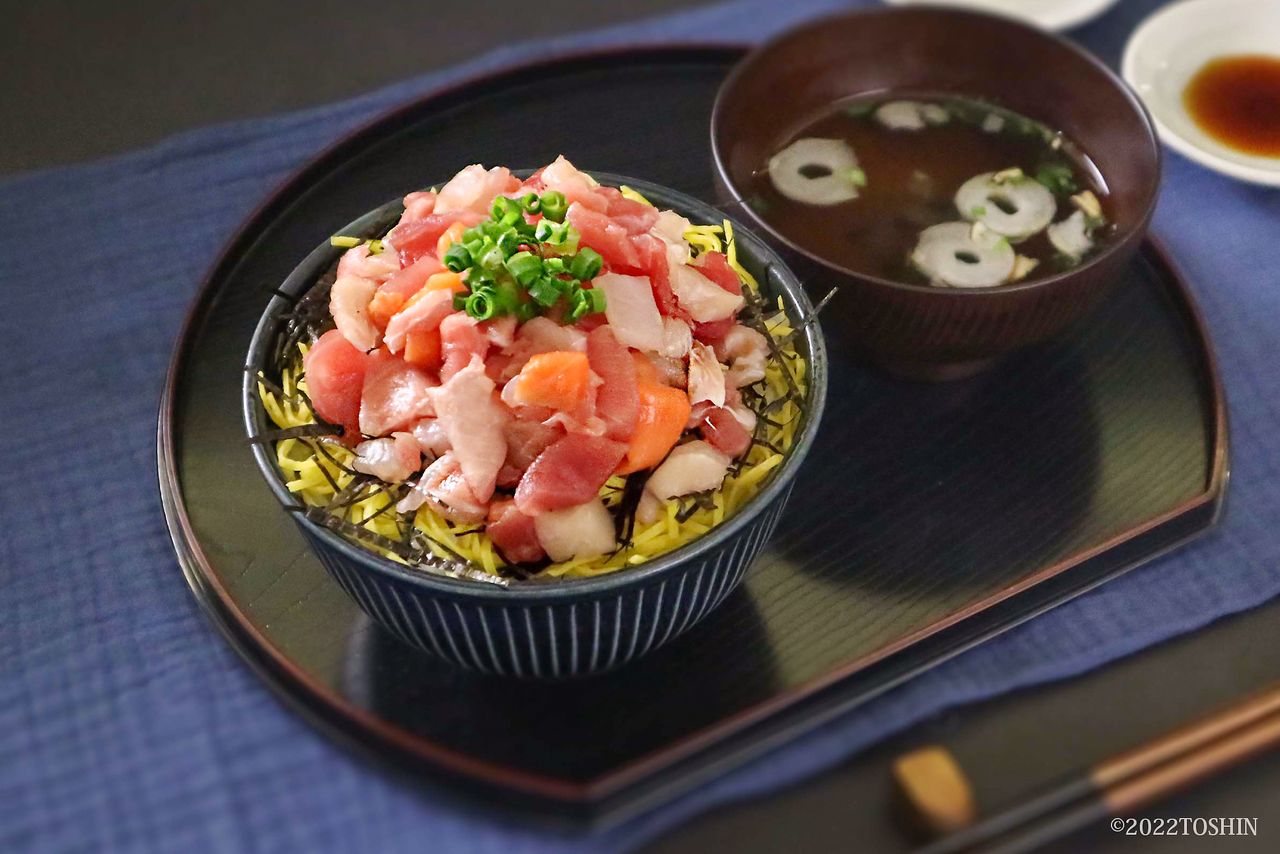
Tōshin’s seafood donburi, which includes vinegared rice. It is hard to tell that it is made with frozen fish. (Photo courtesy of Tōshin)
Out of concern for the health of residents, retirement homes typically limit the types of raw fish they serve, particularly dark meat fish that have a higher risk of being infected with parasites that cause the debilitating disorder anisakiasis. In most cases, facilities offer non-fish items like rolls wrapped in nori that contain cucumber and kanpyō, rolled omelets, or inarizushi, deep-fried tōfu stuffed with sushi rice.
Frozen sushi offers a safe option as freezing kills troublesome bacteria and parasites. The retirement home reported that residents enjoyed the seafood donburi and showed interest in trying frozen sushi in the future.
Tōshin also hopes that its frozen products can be used for food education at schools. Children enjoy imitating sushi chefs, but forming the rice properly requires skill, discouraging many young chefs. However, the frozen sushi set, with its premade rice beds, makes it easy to feel like a real sushi chef. What is more, the product tastes good, helping kindle interest in eating fish. Foreign visitors to Japan would also relish trying their hand at sushi-making with the frozen sushi set.
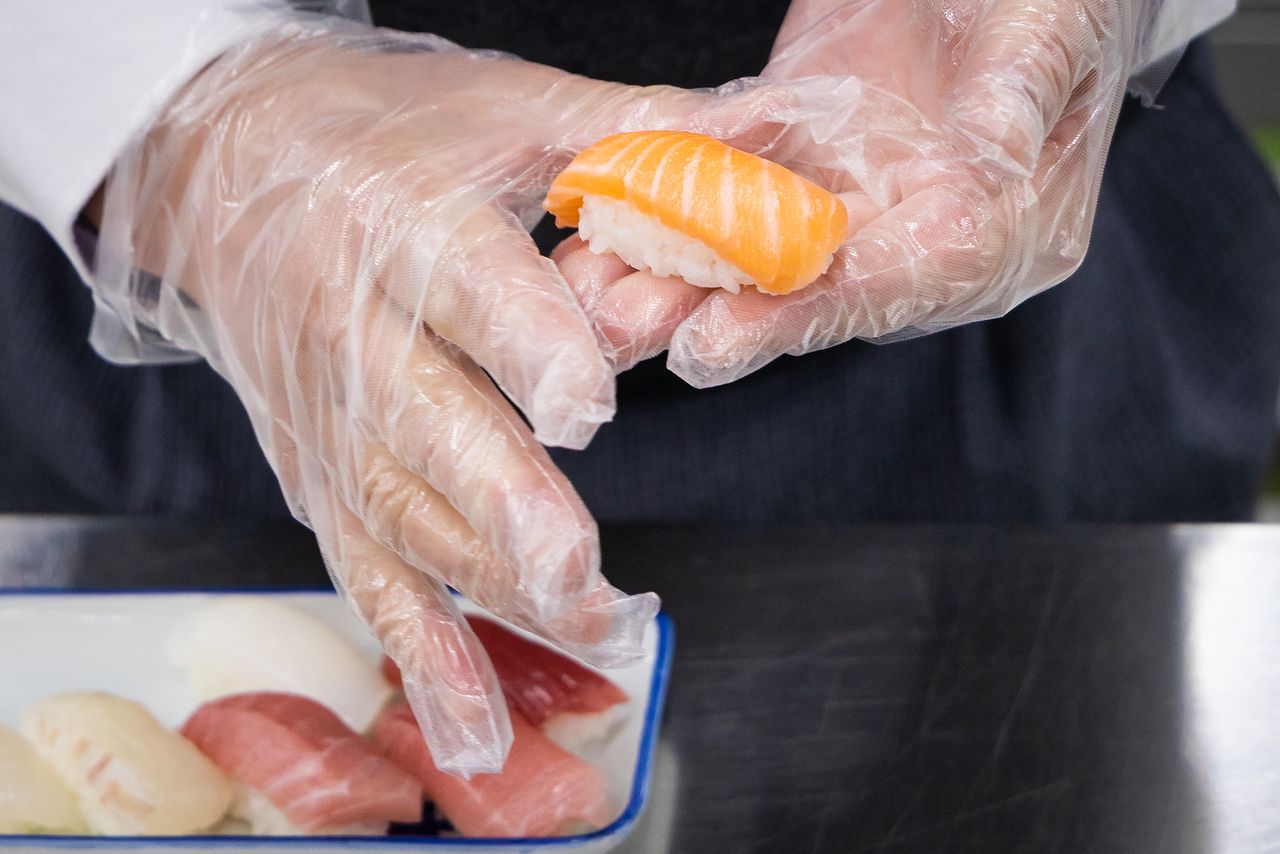
Making his own sushi, the author felt like a real sushi chef. Wasabi can be added and adjusted to taste.
(Originally published in Japanese. All photos by Nippon.com unless otherwise noted.)